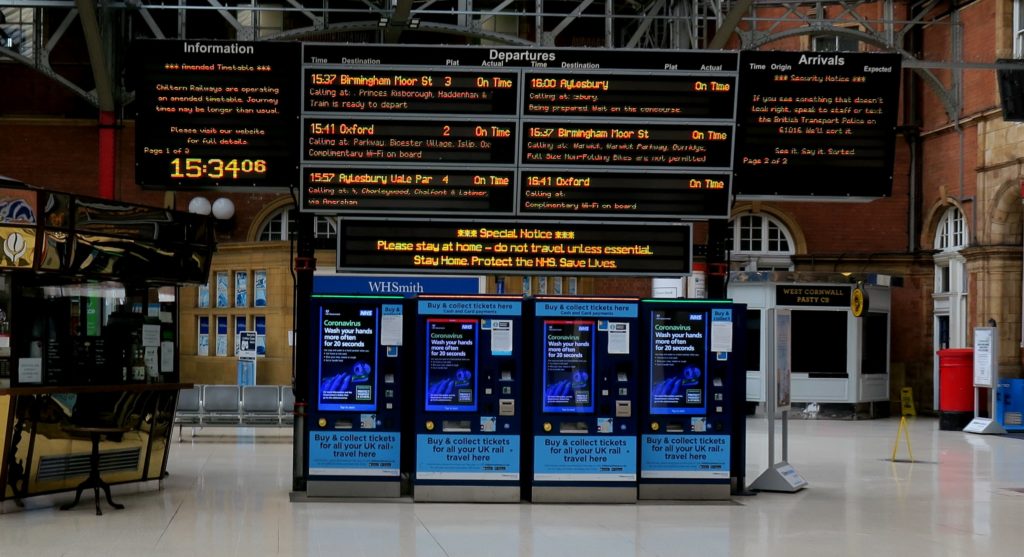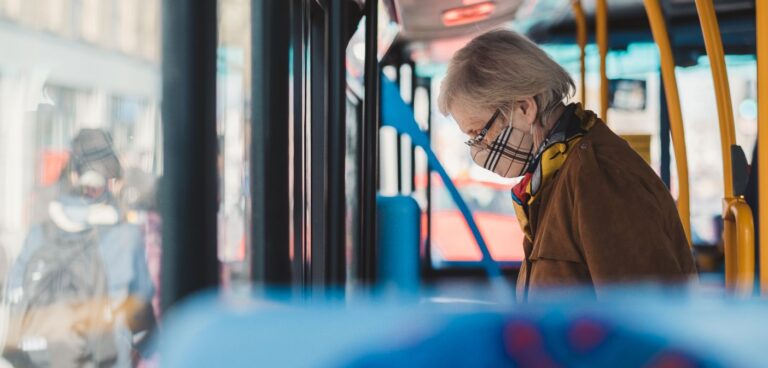From the UK government’s inclusive transport strategy to a myriad of apps that claim to support accessible journeys, how much is really being done to make urban mobility accessible for all? Ursula O’Sullivan-Dale reports…
According to data from the UK Department for Transport (DfT), released in September 2021, disabled adults made 28% fewer trips than non-disabled adults, highlighting a clear imbalance in the use of the UK’s transport services. Some of the main factors contributing to this are exclusionary design processes, inadequate consideration of technology’s role and lack of affordability, among others.
One of the most common and expensive mistakes made by transport providers is a failure to include disabled people in the design process, which results in often expensive retrofits further down the line. Stephen Brookes, rail policy advisor at Disability Rights UK, says: “The economic benefit of inclusion and access is a profound no brainer. Why build something and then have to spend £30,000 putting right? Let [disabled people] get part of it, to make sure the signs are in the right place, to make sure the accessible turning for the wheelchair space is easy to do. Bringing groups together works… it’s a simplistic approach, but it’s called logic.”
It’s important to consider the impact of the increasing digitisation of society on the way people use and access transport. Georgia Yexley, general manager for UK and Ireland at micromobility service provider Tier Mobility, points out that “technology is both an enabler as well as a barrier for vulnerable groups”, adding that it is an important factor to consider, given that “advances in technology have underpinned how we move around our cities”.
Pursuing accessibility from the inception stage onward can help make technology an enabler of accessible journeys, rather than a barrier. Victoria Springthorpe, head of UK and Irish policy and partnerships at fellow micromobility company Bird, makes the point that “it is extremely important to consider accessibility – both in the vehicle design stage and the operational design stage of the service”. According to Springthorpe, taking feedback from a diverse range of stakeholders is vital to ensure mobility services are operated in a way that is non-obstructive to all travellers.
Springthorpe notes the company’s use of an in-house design team and consultation with disabled stakeholders in the creation of Bird’s latest e-scooters, which are designed with longer footplates and shock-absorbing pneumatic tires for a more stable ride. Yet, ensuring the travel needs of all parties are accounted for is not just up to vehicle providers. “Micromobility is a new industry and we don’t operate in a vacuum,” says Springthorpe. “Partner cities must do more to facilitate alternatives to petrol-powered trips that consider the mobility needs of all. Infrastructure is critical here, such as providing protected bike lanes that are wide enough for adaptive vehicles.” Mobility services, including the growing micromobility industry, offer a world of new opportunities for travellers. As Yexley says, “benefits such as improved air quality, taking public space back from the private car and wider environmental benefits should be accessible by all”.
Getting the price right
With the UK in the midst of a cost-of-living crisis, some believe it’s even more crucial the government explores new ways of making sustainable transport accessible to everyone. Duncan Robertson, general manager for UK and Ireland at micromobility outfit Dott, says, “Shared mobility removes barriers to ownership of e-bikes and e-scooters by removing costs of purchase, maintenance and storage. We’re working with a company called Omni in France, and with them we have created an e-scooter that is specially adapted for wheelchair users.”
Accessible micromobility services, especially those adapted for mobility-impaired users, have the potential to offer critical time and cost savings. Affordability is especially important, considering the income inequality between disabled and non-disabled workers. The Office for National Statistics revealed that, in the UK, the gap between median pay for disabled employees and non-disabled employees was 13.8% in 2021. The cost of mobility services is a key component of the accessibility discussion, as disabled travellers are disproportionately likely to be affected by high prices.
As well as affordability, the provision of information is also crucial. It was reported this year that the British government and railway industry plan to close almost 1,000 ticket offices and to phase out physical tickets across the UK rail network. These could risk denying some people access to vital information and potentially exclude them from essential journeys.
Better by design
Network Rail’s redevelopment of Glasgow Queen Street Station is an example of the power of inclusive design. A disabled access consultant worked with the development and design team from the inception phase and coordinated meetings with inclusive discussion groups. As a result, Glasgow Queen Street Station includes two fully accessible entrances, including both a ramp and a step-free lift, as well as both accessible and Changing Places toilets.

Digital divide
What’s more, An Ofcom report published earlier this year claimed that 26% of those aged 75 and above in the UK do not have internet access. In addition, according to data from Statista, 35% of elderly people don’t personally own or use a smartphone. This means a significant portion of the population cannot use smart technology or the web to reliably access transport. On the decision to axe certain ticket services, Brookes says, “Ticket offices aren’t just about selling tickets, they’re about supporting information. What concerns me is that we are creating a divide where those that have access to smart technology can access travel and those who haven’t can’t.”
This digital divide doesn’t just apply to ticket offices. Increasing digitisation across all forms of transport provision – from websites to digital payment options – represents a serious problem for some communities. Dr Harrie Larrington-Spencer, a research fellow at the University of Westminster, says: “Technology can be a fantastic enabler of access to mobility services and will be a significant element of our urban transport provision moving forward. However, apps need to be designed with digital accessibility and ease of use at the forefront of design.”
By failing to consider digital accessibility standards, even those with access to smart technology risk being excluded from service provision, believes Larrington-Spencer, who adds that there are “people in society who will not have access to the resources needed to use this technology, in terms of skills [and] cost”. According to Larrington-Spencer, it is vitally important that “systems take this into account and have provisions for such people” to avoid social exclusion from transport services.
Springthorpe suggests an alternative through Bird’s text-to-ride service, which allows users without a smartphone to send SMS messages to access vehicles. On the flip side, Yexley points out that smartphones and apps mean providers can be flexible in how their service works and can enable them to offer a service in areas where more common alternatives are not sustainable. It also means they can remove some physical barriers, such as the docking process.
Better by design
Network Rail’s redevelopment of Glasgow Queen Street Station is an example of the power of inclusive design. A disabled access consultant worked with the development and design team from the inception phase and coordinated meetings with inclusive discussion groups. As a result, Glasgow Queen Street Station includes two fully accessible entrances, including both a ramp and a step-free lift, as well as both accessible and Changing Places toilets.
The definition of accessibility is often reduced to the utility of a service for those with impaired physical mobility. However, not all disabilities are physical or clearly visible. For those with learning disabilities or neurodiverse people, clarity of signage and information displays are also critical. Successfully finding and boarding a service means very little if passengers cannot successfully reach their destination, making information displays key to journey completion.
Two central factors to consider here are text display and colour contrast. Dr Nick Tyler, Chadwick chair of engineering at University College London, explains: “Contrast is very important. Dot matrix is very old technology, and one of the disadvantages is around the clarity of lettering.” He adds that it is much more important that people be able to distinguish the shape of a word on a sign than the individual letters. This is because, when all words on a display are presented in a uniform structure, specific location names cannot be clearly distinguished by shape. This makes finding a destination more challenging.
Some forms of assistive technology are easier and cheaper to implement than others. For example, research from the House of Commons Library states that, as of January 2019, all stations in the UK are fitted with hearing induction loops, a form of assistive listening technology. This means all UK stations have at least one form of disability assistance.
However, this level of provision does not support the independence of as many passengers as possible. A study from the Disabled Persons Transport Advisory Committee (DPTAC), published in February this year, revealed that fewer than 2% of all stations have level access on the platform, which enables a wheelchair user board or alight a service without assistance.
Tyler suggests an inclusive “transport system is one where everyone is participating as fully as they wish”. Considering this, wheelchair users or other passengers unable to cross the train-platform divide are denied the total independence available to other passengers. Even for stations that do offer ramps, provision doesn’t result in true equality. This is because passengers who are unable to navigate the train-platform gap cannot travel without either pre-planning and/or rail staff assistance.
The same DPTAC report also reveals that 20% of UK stations do not guarantee the needed on-board staff to set up a ramp, creating further barriers for mobility-impaired passengers. Brookes says: “It’s not that we want better than everyone else, we want equal opportunities. There are still so many decisions that are made for disabled people without including them.”
Missed opportunity?
Leeds City Council plans to make changes to relocate Leeds railway station’s taxi rank, which will remove a step-free access point. According to Tim McSharry, head of disability and diversity for the Access Committee for Leeds and Access Usability Group (AUAG) spokesperson, the update will force passengers to use new stairways, public lifts or face an additional 150m detour. “This will massively impact those with impaired mobility and access needs,” says McSharry. “We continue to oppose the plan and have provided evidence on how it could be unsafe and offer disadvantageous passenger experiences, but the council has yet to change its plans.”
This article was originally published in the September 2022 issue of CiTTi Magazine. Read the original article.





